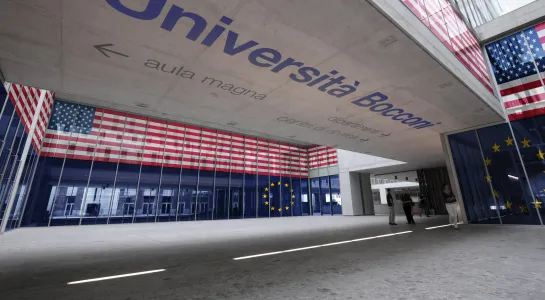
The European Consequences of the America First Approach
Whether it is Democrat Kamala Harris or Republican Donald Trump who wins the upcoming US presidential election, the country’s trade policies will be marked by strong continuity: with that of the Biden administration for the former, and – for the latter – with that of his own term. To understand the possible scenarios for Europe, it is therefore useful to recall how things went during the last two presidencies.
Before Trump, it was easier for the rest of the world to understand the American approach to international relations.
There was both a Republican and Democratic course of action, but the will of the United States to unite allies around common interests was clear – just as clear as US leadership on related common actions. This clarity was blurred with Trump, whose campaign slogan “Make America Great Again” immediately recalled “America First” – the motto of past American administrations, both Democratic and Republican. In fact, between the two World Wars, these administrations pursued a more neutral approach compared to that taken in European affairs.
Over time “America First” became the motto of an isolationist foreign policy stance, which the Trump administration interpreted as the systematic US withdrawal from international treaties (the Paris Climate Agreement and Iran Nuclear Deal, among others) and international organizations (the United Nations Educational, Scientific and Cultural Organization – known as UNESCO – as well as the World Health Organization, among others). Trump also attacked NATO, the North Atlantic Treaty Organization, and hindered the work of the World Trade Organization – both weakening the multilateral strategy to international trade and launching a unilateral trade war against China.
It is a war whose side effects have not spared long-time allies, both European and North American. In short, with Trump, the United States had paradoxically renounced its role as guarantor of a world order designed largely in its own image and likeness, as well as – according to those most critical – for its own use and consumption after the Second World War. It did not take much to go from “America First” to “America Alone”.
With Joe Biden's presidency, there has been a reversal to some extent, thanks to a return to coherence and clear foreign policy goals. In January 2021 Biden rejoined the Paris Climate Agreement, and has even considered US accession to a modified version of the Iran Nuclear Deal. He has reassured allies that “America is back”, emphasizing the importance of NATO and making his leadership heard when dealing with global issues ranging from climate change to humanitarian emergencies. With Biden, the US has sought to regain its central role on the global stage, reuniting its allies around common goals.
However, those who expected a major break also in terms of trade policy were left disappointed because “America First” is actually not Trump’s invention; rather, it is an idea that – as noted above – began long ago. On the one hand, although with less polite tones and less articulate actions than those of his predecessor, Trump simply continued the protectionist trajectory that had been present during Democrat Barack Obama's term, which was reinforced in the aftermath of the 2008 financial crisis. On the other hand, Biden made public his programmatic manifesto on economic policy during his campaign, and the title – “Ensuring the Future is Made in all of America by All of America’s Workers” – spoke volumes. From Made in America to Made in all of America.
The document's introduction doubles down on the message, with Biden stating that he did not accept “for a second that the industrial vitality of the United States is a thing of the past. During the Second World War, US industry was the arsenal of democracy and today it must be part of the arsenal of American prosperity.”
Trump's creativity can be attributed to the use of pieces of legislation (unknown to non-experts because they have rarely been used previously) to impose tariffs on imports, especially those from China. Among such legislation is Section 201 of the 1974 Trade Act, which allows for the use of temporary tariffs to give American industries relief from import competition.
Section 301 of the same act gives the US government the power to use tariffs to defend its industries against unfair trade practices carried out by other countries. Section 232 of the 1962 Trade Expansion Act allows the president to impose tariffs on imports that threaten national security by harming critically important industries.
While Biden has always disapproved of Trump’s tariffs, he has removed very few of them. He has also added other discriminatory industrial policy measures against non-US firms, under both the 2022 CHIPS and Science Act (aimed at reducing dependence on Chinese semiconductor production) and the 2022 Inflation Reduction Act (intended to spur clean energy technologies within domestic borders). In short, from Obama to Biden via Trump, the American protectionist trajectory has remained consistent with itself.
What to look forward to with Harris or Trump II
So which aspects can distinguish a Harris presidency from a second Trump term?
Mainly three. The first concerns the fact that reduced reliance on Chinese imports will continue to be an instrumental goal of US trade policy.
While Trump will pursue “de-coupling” (i.e., complete separation of the Chinese and American economies), however, Harris will aim for “de-risking” (or selective separation according to the criticality of products).
The second distinction is related to the first, and concerns Trump’s measures having more geographical connotations such as those aimed at targeting China to reduce a bilateral trade deficit, seen as the result of unfair competition and a national security risk factor.
On the other hand – in the wake of a Biden presidency – measures proposed by Harris will have a more industry-based connotation, seeking to ensure strategic autonomy with respect to products deemed crucial.
Lastly, to reduce reliance on imports of such products from China, Harris will follow up on the current administration's multilateral efforts to strengthen trade relations with other Asian countries. Two examples include the 2023 US-Taiwan Initiative on 21st Century Trade and the Indo-Pacific Economic Framework (IPEF), launched in 2022 but still under development.
Instead, from Trump, one can expect a return of US diplomacy to an opportunistically bilateral – if not blindly unilateral – approach, as in the case of the vague 10-20% “universal tariff” to be imposed on all imported goods, regardless of the country of origin, in order to curb the trade deficit that the United States has not only with China.
Faced with these alternative scenarios, Europe will be called upon to make a difficult decision between pursuing US protectionism or taking advantage of the diplomatic and economic opportunities that US isolationism could offer.
If Trump becomes president, the second option will be more palatable given the futility of pursuing those who are unrelenting when it comes to their affairs.
If the presidency goes to Harris, though, the most favorable choice for Europe might be to take advantage of synergies with the United States, made possible by their multilateral approach – to pursue its own “de-risking” in tandem.

